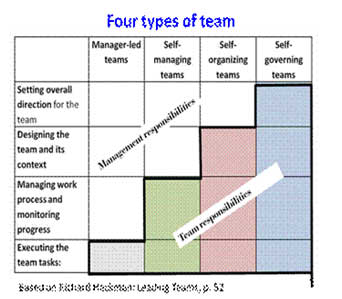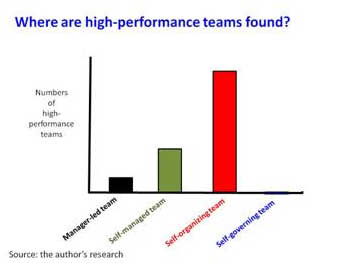Most high-performance teams are self-organizing teams
My research on high-performance teams encountered some manager-led teams. In manager-led teams, management appoints a team leader and the leader becomes the boss of the team. The team reports to the leader. It’s a team, yes, but the team is also an extension of the hierarchy. Everyone looks to the leader for instructions.

However most of the high-performance teams were not manager-led teams. They were teams where the management had deliberately stepped back, or was inattentive or where one reason or another was totally absent, thus enabling the team to self-organize. It’s as though there was a tear in the fabric of the universe, an open space that was created, and lo and behold, the self-organizing team emerged.
What generates the energy and passion of self-organizing teams, and their eventual high productivity, is that the members enjoy the opportunity to organize their own work and contribute their full human potential to the collectivity, rather than being limited to what the organization thinks it can absorb, and only at those moments when it is ready to absorb it.
Interestingly, my research encountered no examples of self-governing teams in big firms in a high-performance mode. Self-governing teams rarely if ever attain a high-performance mode, apparently because the struggle to decide what to do gets in the way of actually doing it.

Perhaps an exception to the rule that high-performance teams are self-organizing, but not self-governing, would be a startup company that is growing in an organic fashion, based on the collaboration of a group of equals. Such a firm can be quite agile, so long as it stays small. The problems begin when it begins to grow, and then walls of divisions and departments start to grow, and the firm begins to slow down, as departments and divisions and layers of management begin to form.